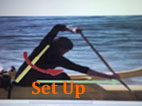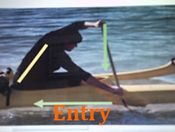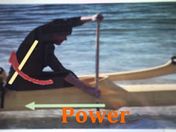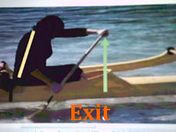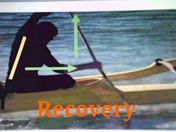Waka Ama : Paddling Technique
From WikiEducator
< NZ | NCEA | Level2 | PhysicalEducation
| Waka Ama Home | < |
| Table of contents |
|---|
|
5 Phase Forward Stroke Technique
There are many different paddling techniques that a paddler can learn depending on their coaches preference. Please note that this is only one way of learning paddling technique. The images are indicative only, Feel free to add another page with your method of technique. Fox, C. (2009).[1]
| 1. Top Arm - Reach across to the opposite side line up both top & bottom hand. Elbow bent and relaxed. Lower Arm - full extension, slight lean forward and twist at the hip, see the red arrow and yellow line. Do not grip the paddle hard, this will only tighten your muscles, you want them relaxed. The red arrow is the beginning stages of the rotation. The rotation will give you a few more inches in your reach for the water in the front of the waka and will come into play with the power phase. | |
| 2. Entry should be clean and crisp with no splash. If you pull before full entry of the blade, you will cause cavitation or air bubbles between the water and the blade. Top hand uses vertical force (see green arrow) to bury the blade into the water. Water will load on the back of your blade which is the 'catch' phase. | |
| 3. When the 'catch' applied, the large muscle groups and shoulder are engaged to start the power stroke. Think of the stroke length being 100% from entry to exit. The power stroke is only the first 20% of the stroke. Aim to apply the power at that first 20% of the stroke length, propelling your waka forward. The second part of the rotation is activated simultaneously see the red arrow. The direction of the rotation is reversed and your torso returns to vertical position. | |
| 4. Exit of the paddle starts at the knees. Allow the paddle to naturally complete the stroke while the top hand pulls the paddle vertically upward to exit. Do not allow the paddle to stroke past your hip, this will only cause drag and thereby slow down the waka. | |
| 5. On the recovery, feel the twist of your shoulder moving your bottom arm forward, so there is no arm strength involved, it will just stretch out to the set up position. Relax during this phase. The lower hand should return along the gunnel or hull on the same path as the power phase. Movement is just forward and back, the shortest distance is a straight line, take advantage of it. To accomplish this, the top hand will create a small circle to return to set up position. Keep in mind that the larger muscles, the latissimus dorsi are the major movers, rotation at the hip occurs when returning to Set Up. |
Technique - AudioVisual
 References
References
- ↑ Fox,C. (2009). Technique-rotation-vs-lunge. (Chris Fox, DipSpSt Otago University, email contact: 2011.renard@gmail.com for further information). Retrieved May 20, 2010, from http://www.worlds.wakaama.co.nz/wp-content/uploads/2009/06/Technique-Rotation-vs-lunge.pdf
NZ/NCEA/Level2/PhysicalEducation/WakaAma/PaddlingTechnique. (2024). In WikiEducator. Retrieved December 22, 2024, from https://wikieducator.org/NZ/NCEA/Level2/PhysicalEducation/WakaAma/PaddlingTechnique (zotero)
